|
The Big Picture: Directors & Boards magazine has been tracking new director announcements and the subset of women directors added to company boards since 1994. Most other reports, primarily by women's organizations, are produced once a year or alternate years and typically cover only the top tier of corporations (Fortune 500 firms). D&B data tracks quarterly and annual new director additions, the companies, and the women named to major boards. The annual figures for the past 16 years are presented in the chart to the right.
The History: Total new directors and the number of companies announcing new directors have been synchronized for most of this period, although two trends are clear. First, there is a downward trend in the number of total new director announcements since 1997. Second, there is a convergence of companies and director announcements which means that, in the past, there were more directors announced per firm than is the case currently. Only the number of new women directors (shown in aqua at the bottom) has shown a steady pattern with a slight uptick in the past two years.
Overall, the average for the past 16 years was 601 companies announcing 732 new directors of which 113 (15.5%) were women directors. |
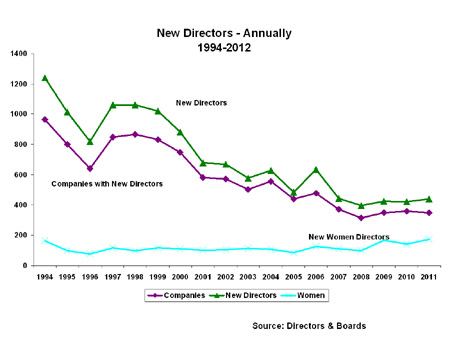 |
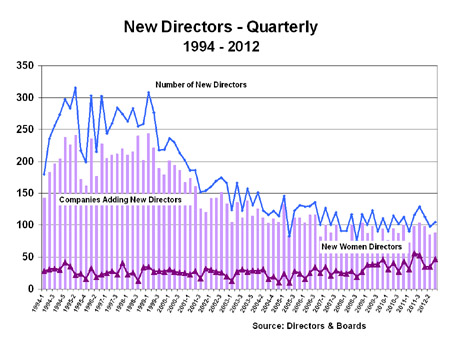
Quarterly Detail Going down to the quarterly detail level, we begin to see the volatility in both total announcements and companies announcing new directors. New women directors also show volatility, but women have been more consistent than the other two series.
Focusing only on the women director announcements and their percentage share of the total (see the chart below) on a quarterly basis begins to highlight two trends. First, women director announcements are extremely volatile (the number of women are measured on the left axis). Second, there has been a slight uptick in the recent years, contrary to most media reports. The highest recorded women's share (percentage is measured on the right axis) was 43.3% in 3rd Q 2009, but out of only 90 total director announcements. The year 2009 averaged 38.9% overall, while 2010 averaged 33.8% women as a percentage share of all new director announcements tracked by Directors & Boards magazine.
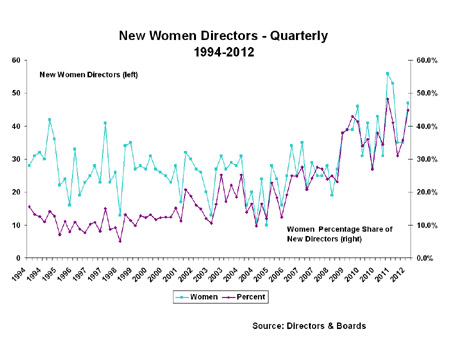
Note: Directors & Boards data information is taken from individiual issues of the quarterly magazine, with the assistance of James Kristie, Editor and Associate publisher, and Kelly McCarthy, Research Associate at Directors & Boards.
Contact: For questions regarding this report, contact: EG@ChampionBoards.com.
|
Compared to What? How does the Directors & Boards data compare to that of NewsOnWomen.com, which also has tracked new women director press releases since 2005? The chart below compares the quarterly data for the two sources over that period. NewsOnWomen.com records about 2.3 times more women directors than D&B because it captures announcements from smaller NASDAQ and private firms which Directors & Boards might not cover. But both series reaffirm the very high volatility. And it appears that the differences between the two sources of data are getting smaller.
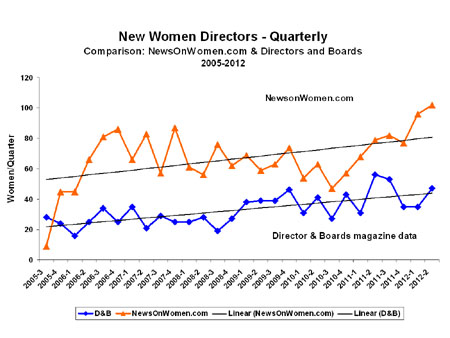
In the same chart, below, we have added a linear trendline (in black) to both data series. Those trendlines clearly are positive, even though with just a slight slope. We believe the trend could be stronger and more positive. However, it could be much worse. Compared to the obvious declines in total number of directors and the number of companies announcing new directors, this data "ain't so bad after all."
Also, see our report on the contraction of businesses described in our guest contributor article for The Conference Board. One important topic that women need to address is whether women are adding to the creation of net new businesses, creating companies, building companies of $1 M revenues and more, founding companies with employees, taking companies public and forming net new corporate boards. If women today represent over half of the business intelligence trained at business and law schools, then they should appear in the other data that describes the creation of net new economic entities. That is where boards of directors thrive.
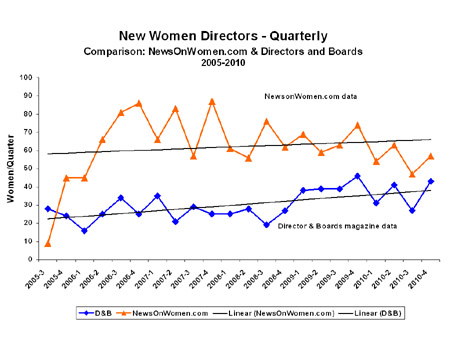
|